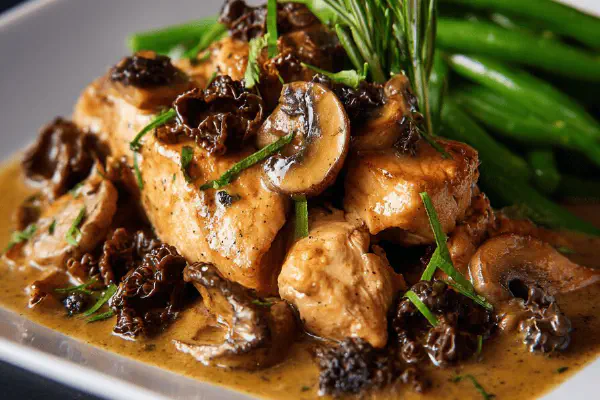Hearty Chicken Bone Stock

By Emma
Certified Culinary Professional
Ingredients
- 1 chicken carcass with some meat attached
- 2 carrots roughly chopped
- 2 celery stalks roughly chopped
- 1 large onion quartered
- 3 cloves garlic smashed
- 2 bay leaves
- 10 black peppercorns
- 5 sprigs fresh parsley
- 1 tablespoon apple cider vinegar
- 8 cups cold water
About the ingredients
Method
- Start by stripping all remaining meat off the carcass. I save this for later use—great in soup or salad. Toss carcass into a large heavy pot.
- Add carrots, celery, onion, garlic, bay leaves, peppercorns, and parsley. Cover with cold water about 8 cups, enough to immerse everything but avoid overflow.
- Bring that pot up to a rolling boil on high heat. You’ll see foam rise—not appetizing, but skim it off with a slotted spoon. Don’t fret if you miss some; it’s about clarity and flavor purity.
- Turn heat down to lowest simmer. Now, vinegar time—pour in about a tablespoon of apple cider vinegar. It’s magic for dissolving collagen and minerals from the bones. Don’t skip this. Wait 15-20 minutes after adding vinegar before any real simmering starts.
- Simmer slowly and gently for just over 3 hours, maybe 3 hours 15 minutes. The surface should barely bubble. You want a quiet simmer so flavors meld and collagen turns gelatinous but doesn’t break down completely.
- Occasionally press the veggies and bones down with a spoon. Foam may reappear—skim again if you want but it’s optional. Keep a watchful eye for browning on bottom which can affect taste; if bubbling gets too aggressive, lower heat.
- After simmering, strain stock through fine mesh sieve into a big bowl. Use a ladle to coax every drop, pressing veggies gently to wring out deep flavors.
- Let the broth cool uncovered at room temp 30-45 minutes to let steam and heat rise. Then chill in fridge for an hour or so. When cold, it should jiggle—good gelatin presence.
- Store that stock in airtight containers. Refrigerate up to 5 days; freeze for months—perfect for long-term.
- If stock tastes flat, try adding a small splash of soy sauce or mushroom soaking liquid next time. No carrots on hand? Parsnip or fennel can add interesting sweetness. No vinegar? Try white wine or lemon juice, but less acid impact.
- If bones alone, no meat—longer cook times help extract flavor. Roast carcass first if you want deeper color and nuttiness.
- Avoid boiling hard which forces cloudiness and bitter flavors. Slow bubbles, patience, and skimming make the difference between ’meh’ and memorable stock.
Cooking tips
Chef's notes
- 💡 Start with cold water always. Hot water clouds broth quick, messes with clarity. Apple cider vinegar key for breaking down collagen—don’t skip it. Add vinegar early, wait 15 minutes before simmering hard. Foam rises like little bubbles popping, skim with slotted spoon, helps keep broth clear but missing some isn’t disaster. Heavy pot helps maintain low steady heat; high flames scorch bones and layer bitter tones.
- 💡 Simmer low. Not boil. Bubbles barely move surface; steady almost silent bubble. Loud boil agitates fats and proteins too much, adds cloudiness and off tastes. Press veggies and bones down occasionally with spoon to release flavor. Watch bottom for browning—if starting, drop heat. Skimming foam again optional after stirring. Patience pays in depth and subtle sweetness.
- 💡 After simmering, strain through fine sieve, press veggies gently but firmly. Don’t squeeze like juice but coax all liquid out. Cool broth uncovered for 30-45 minutes to let steam and heat leave. Then chill in fridge until jelly-like shows up. Rapid cooling traps condensation, bacteria risks. Store in airtight containers refrigerated 3-5 days or freeze multiple months. Portion sizes for easier thawing.
- 💡 No carrots? Parsnips or fennel add sweetness alternative. Vinegar alternatives include white wine or lemon juice but note acidity level lower, affects extraction speed. No meat on carcass means longer cooking or roasting first for deeper flavor and color. Foam explained: proteins and impurities gather; you want clear broth, but skimming too often can lose flavor. Use scraps cooked, raw bones cloud broth more.
- 💡 Watch for key aromas as cooking goes: earthy mingles with sweet savory, broth deepens color from pale yellow to golden amber. Sounds change too—quiet simmer whistles versus rolling boil roar. Cooling phase crucial for gelatin formation that gives body. No vinegar means less jelly. Try soy sauce splash or mushroom liquid if flavor flat next batch. Storage tips: freeze small portions, thaw gently in warm water bath, not microwave.
Common questions
Why add apple cider vinegar?
Breaks down collagen minerals in bones slow. Wait 15 minutes soaking before simmer. Without it broth shallow, less body. Alternatives? White wine or lemon juice but less acidic, slower extraction.
How to keep broth clear?
Cold water start, skim foam protein scum early as foam rises. Bubbles gentle, don’t boil hard. Use heavy pot to keep low even heat. Raw bones cloud more, roasting helps. If cloudy refrigerate overnight, fat rises then skim.
What if stock tastes bland?
Add splash soy sauce or mushroom soaking liquid next batch. Sometimes veggies not pressed enough or vinegar missing. Also check simmer temp low enough. Can try longer cook time but risk bitter flavors.
How to store and reheat?
Refrigerate airtight 3-5 days, freeze several months. Freeze in small portions for faster thaw. Warm water bath thaw better than microwave to keep texture. Avoid sealing hot stock to reduce bacteria risk.



